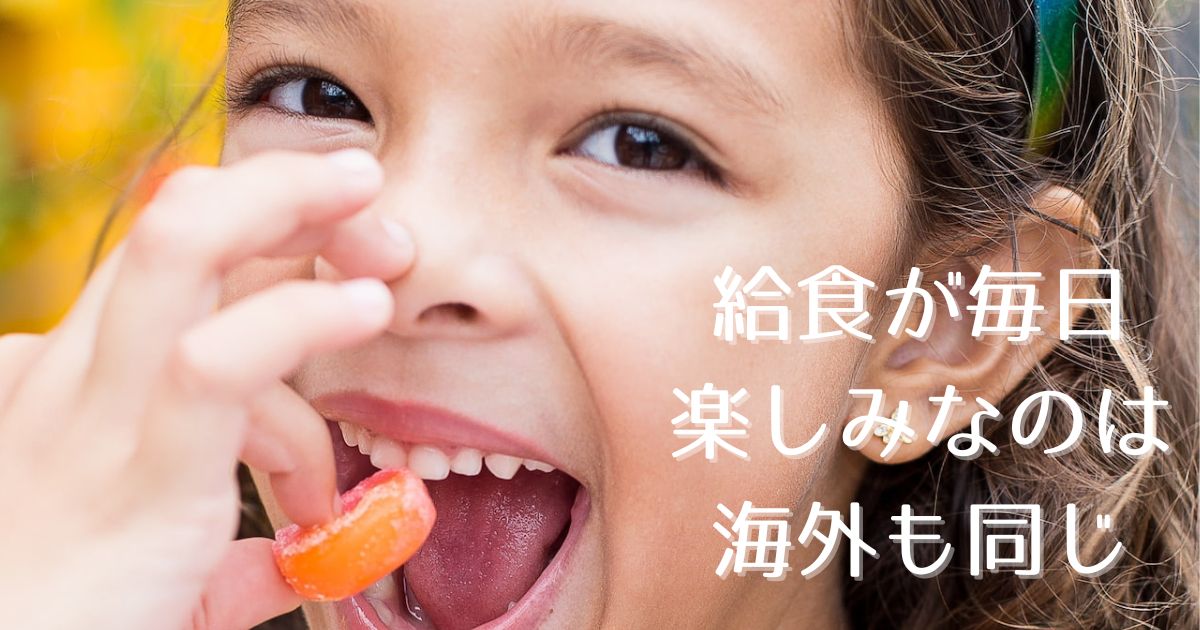This article was written in Japanese and English.
まず”スクールディナー”という言葉にびっくりした
「ディナー」と聞くと,「夕食」のイメージはありませんか?私は学校で初めて給食を食べた日に「スクールディナーはどうだった?」とホストマザーに訊かれました。まさか「学校」と「夕食」が組み合わさると思っていなかったので,私は「スクールディナー」という言葉を初めて聞いたときに「給食のことか」と理解するのに時間がかかりました。調べてみると,ディナーは夕食ではなくてもその日に食べるしっかりした食事,メインの食事を表すときに使うようで,勉強になりました。私はホストファミリーに夕食をちゃんと用意してもらっていたので1日に2回「ディナー」を食べている感じでした。ちなみに「スクールランチ」という先生もいて,どちらでも良いようでした。
When you hear the word “dinner”, do you have an image of “evening meal”? I never thought that “school” and “dinner” could be combined, so I was very surprised when I heard it for the first time. I found that the word “dinner” is used to refer to a substantial meal or main meal that is eaten that day even if it is not eaten in the evening. My host family prepared dinner for me, so I felt like I was having dinner twice a day. By the way, some teachers called it “school lunch”, and it seemed like either would be fine.
昼に何を食べるのか,毎朝子どもが先生に伝える
日本の小学校の給食はほとんど全員が一緒に食べるし,同じメニューを食べますよね。だからイギリスの小学校で子どもが先生に「給食を食べるのか」を伝える時間が毎朝あったので驚きました。
- 登校後に「レジスター(出欠確認)」という,先生が子どもの名前を呼んで,子どもが返事をする時間がある。
- 「本日のメニュー」が教室のテレビに映っていたり,先生が学級全体に伝えたりする。
- 先生に名前を呼ばれた子どもが,学校給食を食べるなら「本日のメニュー」から選んで先生に伝え,給食ではなく弁当持参なら「パックランチ」と伝える。
- メニューには必ずベジタリアンメニューが入っている。
- 子どもの返答を先生がパソコンに入力する仕組みになっていて,それによって学校のキッチンが適量を用意する。
これはレジスターの入力画面です。
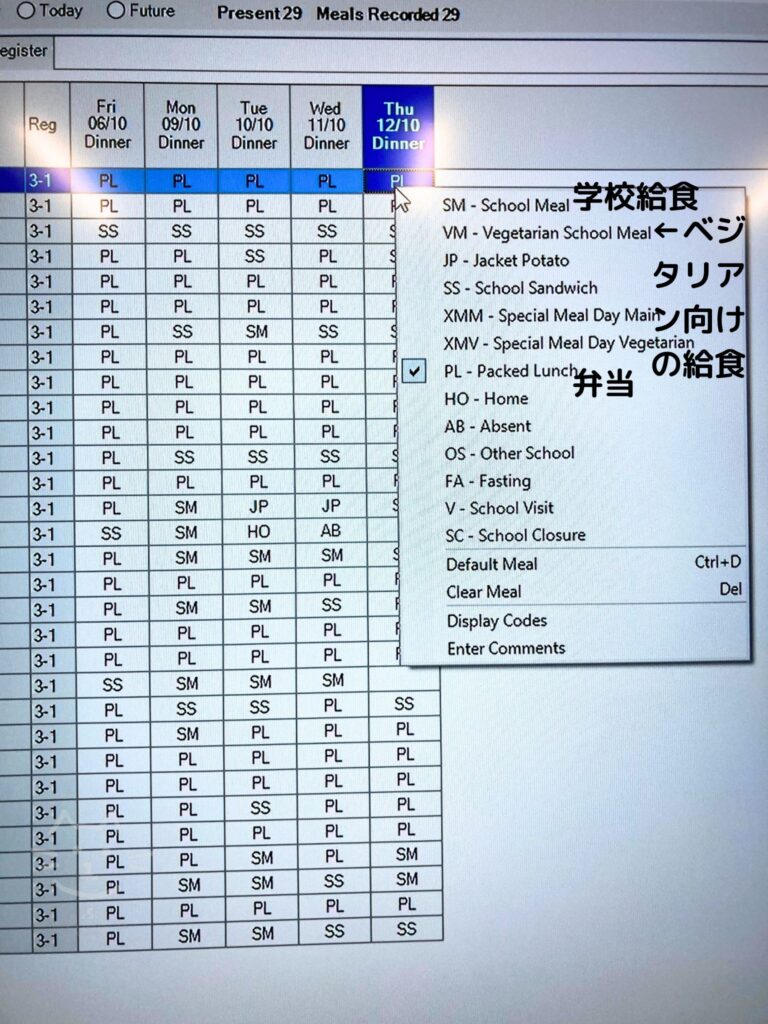
日本の学校では「健康観察」のときに子どもの名前を呼んで,子どもの健康状態を確認しますが,給食を食べるのかの確認はありません。これまでの経験上,体調不良や早退や遅刻,アレルギーがある等の場合を除いて,ほとんど全員揃って同じメニューを食べるのが「当たり前」だったので,「日本と全然違うな」と思ったのでした。
At school lunches in Japanese primary schools, almost all students eat together and eat the same menu. That’s why I was surprised to learn that in primary schools in England, children had time every morning to tell their teachers if they were going to eat school lunch.
In the morning, there is a time called “register” where the teacher calls the child’s name and the child responds.
The “today’s menu” is displayed on the television in the classroom, or the teacher told the children it.
When the teacher calls the child’s name, if the child wants to eat a school lunch, choose from today’s menu” and tell the teacher, and if the child wants to bring a bento instead of a school lunch, say “packed lunch.”
There is always a vegetarian option on the menu.
The teacher inputs the child’s responses into a computer, and the school kitchen then prepares the appropriate amount.
This is the register entry screen.
In Japanese schools, teachers call children’s name during “health check” to monitor the children’s health status, but there is no confirmation as to whether the children will be eating school lunch. Based on my experience, it was normal” for almost everyone to eat the same menu together, except in cases where people were unwell, left early or late, or had allergies, so I thought “This is completely different from Japan.”
教室外で食べる
日本は勉強する教室で食事もします。イギリスの学校は食堂か廊下ホールで食べていました。学校給食を食べる子どもは食堂(写真参照)で,弁当を食べる子どもは廊下ホールに並べられた机で食べていました。

In Japanese schools, children eat in the classroom where they are studying. In English schools, children eat in the canteen or hallway.
給食当番が存在しない
イギリスは日本のように給食当番というものがなく,給食を食べる子どもは食堂に並んで食事を受け取ります。事前に担任に伝えたメニューの場所に並んで,料理を受け取ります。生野菜を食べたい人は自分で皿に盛ります。果物,クッキーやヨーグルトなどのデザートは欲しい人は1種類選べます。
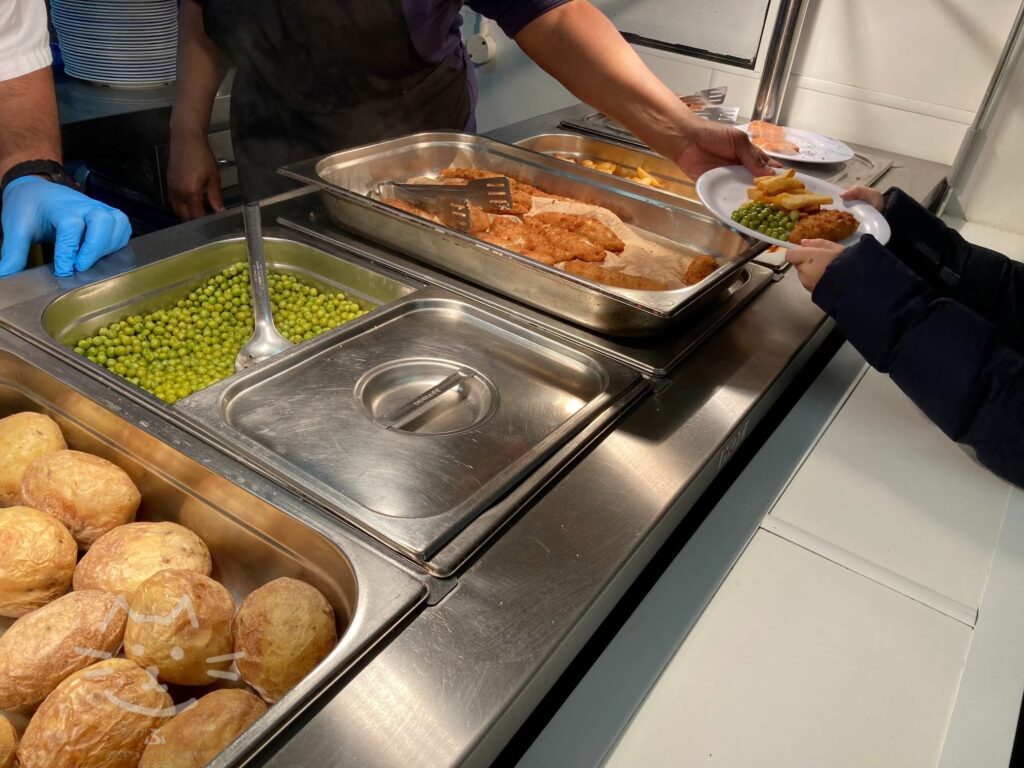
In England, there is no school lunch duty like in Japan, and children who eat school lunches line up at the canteen to receive their meals. They line up at the location on the menu that they have told their homeroom teacher in advance.
日本の給食当番の写真を見せると「クッキング」と思われる
日本の子どもが給食着を着て,食缶からついでいる写真を見せて「何をしているところでしょう?」と尋ねると,100%「クッキング」と言われました。子どもが給食を運んだり,配膳したりすることを知らないと「クッキング」と思いますよね。
When I showed a picture of Japanese children wearing school uniform and holding food cans to children in England and asked, “What do you think are they doing?”, everyone answered “They’re cooking.” If you don’t know that children are responsible for carrying and serving school lunches, you might think of it as “cooking.”
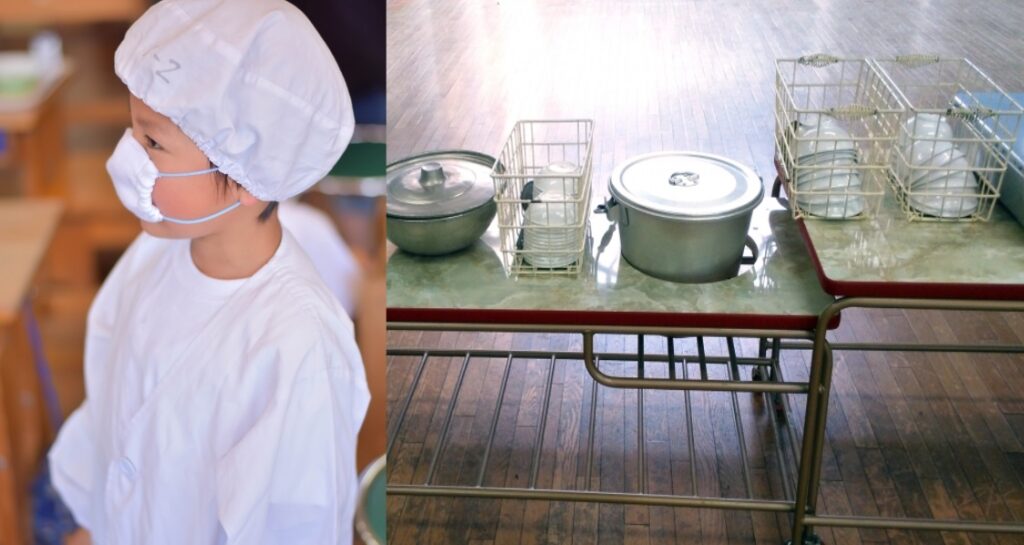
担任は一緒に食べない
子どもは食堂や廊下ホールで食事しますが,担任はスタッフルームで食事をしていました。日本の給食時間は指導の時間なので担任は子どもと一緒に居ます。給食当番の準備,食缶類の運搬,配膳,食事,片付けがあり,「ごちそうさま」まで指導の時間です。だからイギリスではランチタイムに担任が子どもの食事の様子を見ることがないというのは日本と全く違うなと思いました。担任ではない職員が食堂を見て回ったり,掃除をしたりしていました。
Children eat in the canteen or hallway, but homeroom teachers eat in the staff room. School lunch time in Japan is instruction time, so the homeroom teachers stay in the classroom with the children all the time. The homeroom teachers stay with the children, from preparing, carrying food cans, serving, eating, cleaning up, and saying “Thank you for the meal.” That’s why I thought it was completely different from Japan that in England, homeroom teachers don’t watch the children’s meals during lunchtime. Other staff members looked after the children and cleaned the canteen.
そうじは大人がする
食堂も廊下ホールも,子どもが食器や自分のランチボックス等を片付けたあと,大人がそうじします。イギリスでは教員以外の大人がたくさん働いていました。日本の学校は子どもがテーブルを拭いたり,床を掃除したりします。
In both the canteen and the hallway, adults clean up after the children have cleaned up their dishes and their own lunch boxes. In England, many adults other than teachers work. In Japanese schools, children wipe the tables and sweep the floors.
一番好きだった給食は「ジャケットポテト」
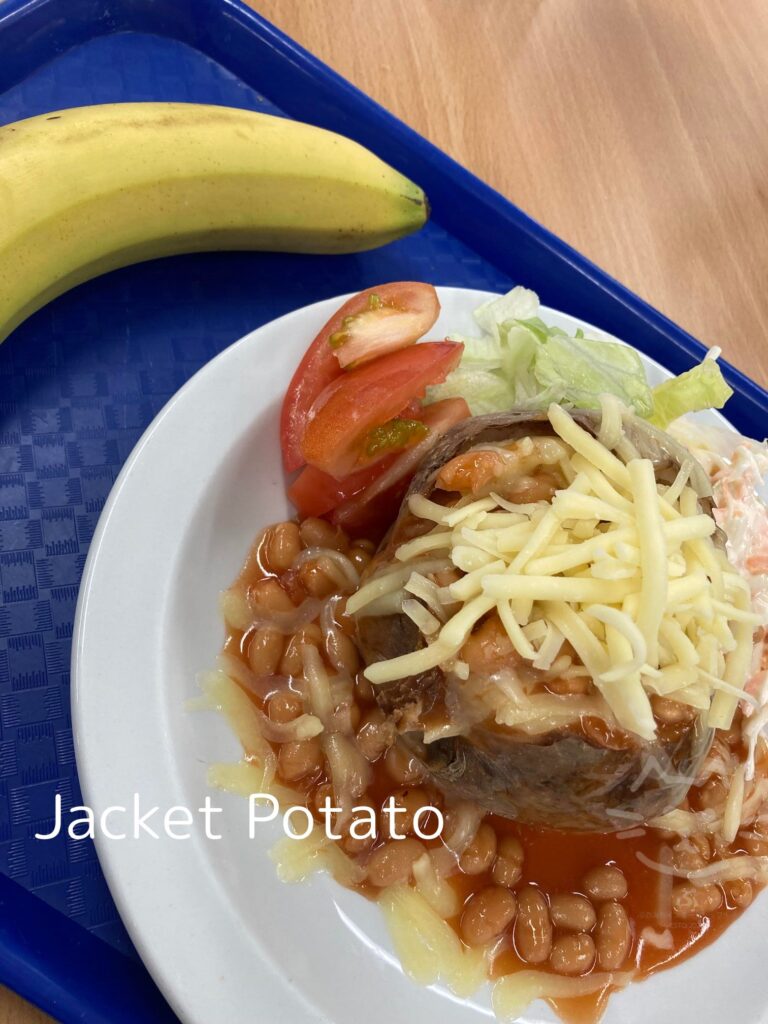
私は事務室に1週間分のメニューを伝えていました。ジャケットポテトは毎日メニューに入っていたので,大体週に2~3回食べていました。オーブンで焼いたジャガイモにかかった豆のトマト煮と溶けたチーズのコンビネーションは最強です。豆類もチーズも大好きなので^^
My favorite school meal is Jacket Potato. The combination of beans cooked in tomatoes and melted cheese is the best.
最後までお読みいただき,ありがとうございました=^_^=

